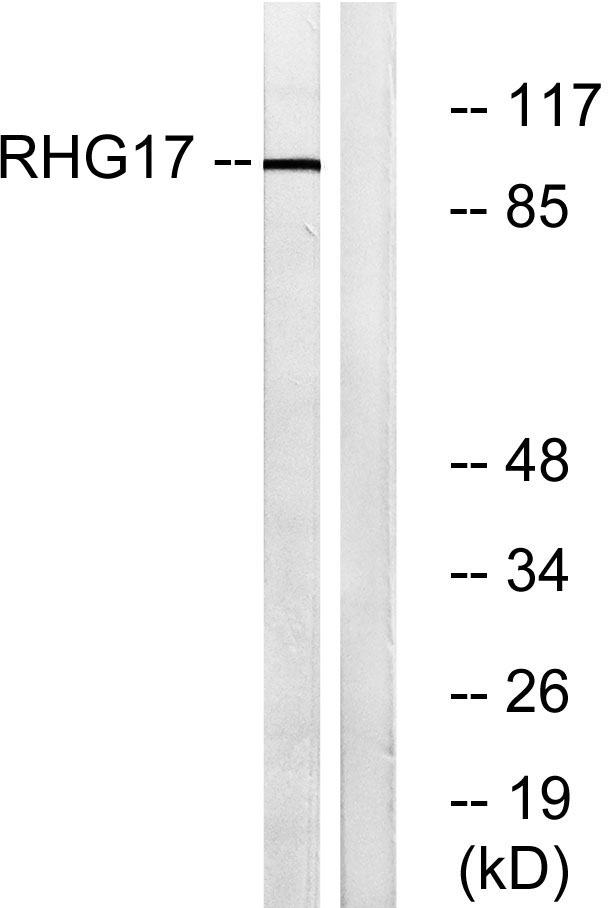ARHGAP17 Polyclonal Antibody
- Catalog No.:YT0316
- Applications:WB;ELISA
- Reactivity:Human;Mouse;Rat
- Target:
- ARHGAP17
- Fields:
- >>Tight junction
- Gene Name:
- ARHGAP17
- Protein Name:
- Rho GTPase-activating protein 17
- Human Gene Id:
- 55114
- Human Swiss Prot No:
- Q68EM7
- Mouse Gene Id:
- 70497
- Mouse Swiss Prot No:
- Q3UIA2
- Rat Gene Id:
- 63994
- Rat Swiss Prot No:
- Q99N37
- Immunogen:
- The antiserum was produced against synthesized peptide derived from human RHG17. AA range:331-380
- Specificity:
- ARHGAP17 Polyclonal Antibody detects endogenous levels of ARHGAP17 protein.
- Formulation:
- Liquid in PBS containing 50% glycerol, 0.5% BSA and 0.02% sodium azide.
- Source:
- Polyclonal, Rabbit,IgG
- Dilution:
- WB 1:500 - 1:2000. ELISA: 1:40000. Not yet tested in other applications.
- Purification:
- The antibody was affinity-purified from rabbit antiserum by affinity-chromatography using epitope-specific immunogen.
- Concentration:
- 1 mg/ml
- Storage Stability:
- -15°C to -25°C/1 year(Do not lower than -25°C)
- Other Name:
- ARHGAP17;RICH1;MSTP066;MSTP110;Rho GTPase-activating protein 17;Rho-type GTPase-activating protein 17;RhoGAP interacting with CIP4 homologs protein 1;RICH-1
- Observed Band(KD):
- 100kD
- Background:
- RICH1 is a GTPase-activating protein (GAP). GAPs stimulate the intrinsic GTP hydrolysis of small G proteins, such as RHOA (MIM 165390), RAC1 (MIM 602048), and CDC42 (MIM 116952).[supplied by OMIM, Apr 2004],
- Function:
- domain:The BAR domain mediates the interaction with the coiled coil domain of AMOT, leading to its recruitment to tight junctions.,function:Rho GTPase-activating protein involved in the maintenance of tight junction by regulating the activity of CDC42, thereby playing a central role in apical polarity of epithelial cells. Specifically acts as a GTPase activator for the CDC42 GTPase by converting it to an inactive GDP-bound state. The complex formed with AMOT acts by regulating the uptake of polarity proteins at tight junctions, possibly by deciding whether tight junction transmembrane proteins are recycled back to the plasma membrane or sent elsewhere. Participates in the Ca(2+)-dependent regulation of exocytosis, possibly by catalyzing GTPase activity of Rho family proteins and by inducing the reorganization of the cortical actin filaments. Acts as a GTPase activitor in vitro for RAC1.,
- Subcellular Location:
- Membrane; Peripheral membrane protein. Cytoplasm. Cell junction, tight junction. Associates with membranes and concentrates at sites of cell-cell contact.
- Expression:
- Ubiquitously expressed. Expressed at higher level in heart and placenta.
- June 19-2018
- WESTERN IMMUNOBLOTTING PROTOCOL
- June 19-2018
- IMMUNOHISTOCHEMISTRY-PARAFFIN PROTOCOL
- June 19-2018
- IMMUNOFLUORESCENCE PROTOCOL
- September 08-2020
- FLOW-CYTOMEYRT-PROTOCOL
- May 20-2022
- Cell-Based ELISA│解您多样本WB检测之困扰
- July 13-2018
- CELL-BASED-ELISA-PROTOCOL-FOR-ACETYL-PROTEIN
- July 13-2018
- CELL-BASED-ELISA-PROTOCOL-FOR-PHOSPHO-PROTEIN
- July 13-2018
- Antibody-FAQs
- Products Images

- Western blot analysis of lysates from LOVO cells, using RHG17 Antibody. The lane on the right is blocked with the synthesized peptide.



